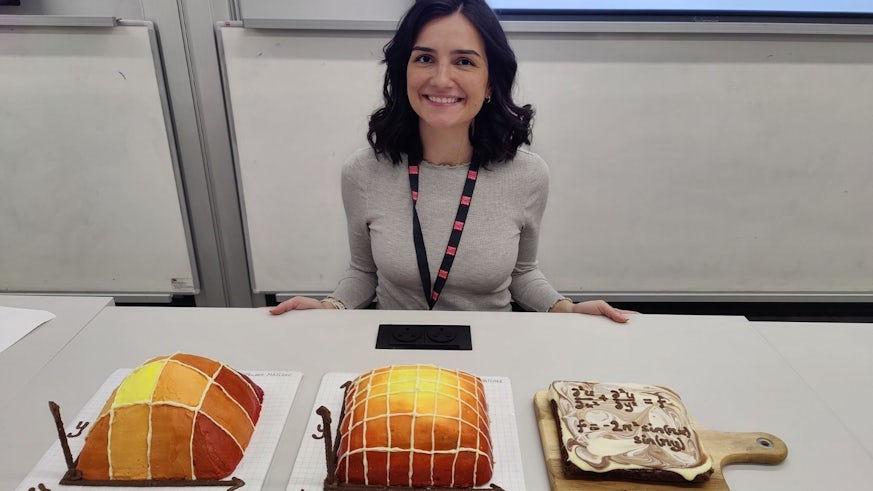Baker’s dozen for Abacws as 13 postgraduate students represent their thesis proposals through cake creations
8 March 2023

Anything but half-baked; thirteen postgraduate Mathematics students have found an innovative way to communicate their research proposals by swapping abstracts for vanilla extracts.
Whilst the assembled proposals addressed a variety of important global topics in mathematical study from animal poaching to cybersecurity, via machine learning to metaheuristics as methods, all attendees agreed that there’s no topic that can’t be improved by the addition of sugar, toffee, and even a pickle pie.
The students not only had to make their topics accessible enough to be understood through a recipe, but the methods and ingredients used had to make sense in terms of their outlined proposals – an innovative task requiring an appropriate amount of food for thought.
Never likely to shy away from a challenge, Cardiff Mathematics’ postgraduate students Ahlam Alghamdi, Tasarla Deadman, Gabriela Filipkowska, Aric Fowler, Naeima Hamed, Matthew Howells, Matt Hutchings, Vasilis Ieropoulos, Timothy Ostler, Thomas Poudevigne-Durance, Sam Richardson, Layla Sadeghi Namaghi and Elizabeth Williams all competed for Star Baker in an event organised by the Cardiff University Student Chapter of SIAM and IMA (formed by the Society for Industrial and Applied Mathematics and the Institute of Mathematics and its Applications, the first SIAM-IMA chapter in Wales) which includes students and faculty members from across Cardiff University who are interested in mathematics or scientific computing and their real-world applications.
Naeima Hamed iced 3D lions onto a cake to show how semantic data integration can aid in forest observatory. Using braided sweet bread to symbolise the Yang-Baxter equation, Tasarla Deadman used equal length braids to support the Yang-Baxter assumption. Thomas Poudevigne-Durance used cupcakes to represent a generative adversarial network that generates new data from an original dataset which learns to replicate the central cupcake’s pattern.
Vasilis Ieropoulos used the structural support of semolina in his Shamali cake to prop up his assumption that using federated learning, machines can not only secure themselves but also contribute to the overall security of the network. Ahlam Alghamdi used a visual representation of the Taylor-Couette problem through utilising two concentric cylinders of dates cake, with viscoelastic toffee sauce that filled and flowed in the gap between them to generate unidirectional flow. In exploring emulsification through local search metaheuristics, Aric Fowler debated whether Simulated Annealing’s randomised approach or the deterministic Tabu Search could find the top of a thickly iced sponge first.
In order to write a thesis, one must first break an egg, or a few, as Timothy Ostler offered, representing the Differential Dynamic Microscopy (DDM) technique, which probes the correlation of time-series images in Fourier space to extract advection-diffusion speeds from small random motion in the cytoplasm for greater success in IVF through profiteroles.
Layla Sadeghi Namaghi opted to represent her thesis not only in the cake but also in the writing of her recipe, ensuring that she folded in Least-Squares method, and a drizzle of ADN theory. Elizabeth Williams opted to form 3D beneficiaries of her research as fondant hospital occupants, as she baked a two-stage stochastic integer programme to determine how to efficiently organise 29 specialties amongst a network of 11 hospitals in a local health board.
Pickle pies made an unexpected but not unwelcome addition to the Bake My Thesis proceedings, as Sam Richardson twisted doughnuts into the shape of a Möbius strip (tautological real line bundle over the circle) arranged in a maximal torus and served it with a blueberry sauce (full of vitamin K).
Matt Hutchings highlighted the Nyström method, a widely used technique for the low-rank approximation of symmetric, positive semidefinite matrices, which involves taking a sample of columns from the target matrix in green points on the cake (random points on the unit circle) and red points of delicious damson jam (optimised points after iterations of gradient descent).
A visual representation of an Operations board game in cake and icing, created by Matthew Howells, showed how building a discrete-event simulation that models patient flows through a holistic orthopaedic surgical pathway enables hospital staff to make more informed decisions on demand and capacity.
With cake being a relatively low-risk activity as far as enjoyment goes, Gabriela Filipkowska opted to explore cryptocurrencies and their relative volatility through systematic and cyber risk perspectives, ensuring he used shiny fruit jam to emphasise the value of currency and chocolate arrows to point to volatile points.
Whilst all the students deserved a commendation for their work in creating edible data sets, there was a winner on the day; Layla Sadeghi Namaghi took the title of Star Baker for Least-Squares and the most culinary flair.
Pleased and energised by her win, Layla shared that “I'm very grateful to have won Star Baker as well as audience's favourite! This competition was a wonderful opportunity for all to showcase the beauty and importance of mathematics in a delicious and accessible way. It was so interesting to see everyone’s research interpreted by such creative means, and to find out that so many of our PGRs are secretly amazing bakers.
My research focuses on developing numerical methods to solve partial differential equations and I really enjoyed the challenge of trying to effectively communicate that in cake form.
Many thanks to our SIAM-IMA committee for organising such a brilliant event. Thanks also to all those who baked, the judges, and the staff and students at Abacws who came along - you all made for such a lovely and memorable afternoon.”
Congratulations to Layla, as well as all the students who contributed on the day to sharing new ways of understanding and celebrating mathematical studies.